Phytosanitary Certificate Application Guidelines
This file contains essential information and instructions for obtaining a phytosanitary certificate. It outlines the necessary procedures and requirements for both consumers and business users. Ensure compliance with USDA standards while submitting the application.
Edit, Download, and Sign the Phytosanitary Certificate Application Guidelines
Form
eSign
Add Annotation
Share Form
How do I fill this out?
To fill out the phytosanitary certificate application, start by gathering all necessary information about your plants or plant products. Follow the instructions carefully to ensure that each section is completed accurately. Make sure to review your entries before submission to avoid any discrepancies.

How to fill out the Phytosanitary Certificate Application Guidelines?
1
Gather all relevant information about your plants or products.
2
Complete each section of the application with accurate details.
3
Review all entries for correctness.
4
Sign where necessary.
5
Submit the completed application as instructed.
Who needs the Phytosanitary Certificate Application Guidelines?
1
Exporting companies that require certificates to ship regulated plants.
2
Importers needing documentation for imported plant products.
3
Agricultural inspectors who validate plant health standards.
4
Distributors handling controlled plant materials.
5
Growers needing certifications for market access.
How PrintFriendly Works
At PrintFriendly.com, you can edit, sign, share, and download the Phytosanitary Certificate Application Guidelines along with hundreds of thousands of other documents. Our platform helps you seamlessly edit PDFs and other documents online. You can edit our large library of pre-existing files and upload your own documents. Managing PDFs has never been easier.

Edit your Phytosanitary Certificate Application Guidelines online.
You can easily edit the phytosanitary certificate PDF using our intuitive editing features. Simply upload the document and make any necessary adjustments directly on the webpage. When you finish, download your revised PDF instantly for convenience.

Add your legally-binding signature.
Signing the PDF is simple with PrintFriendly's digital signature feature. After editing your document, you can add your signature to ensure authenticity. Just follow the prompts to complete the signing process effortlessly.

Share your form instantly.
Sharing your edited PDF is easy with PrintFriendly's built-in sharing options. You can send the document directly via email or generate a link to share with others. Simplifying collaboration has never been easier!
How do I edit the Phytosanitary Certificate Application Guidelines online?
You can easily edit the phytosanitary certificate PDF using our intuitive editing features. Simply upload the document and make any necessary adjustments directly on the webpage. When you finish, download your revised PDF instantly for convenience.
1
Upload the phytosanitary certificate PDF to the editor.
2
Make the necessary edits to the fields and information.
3
Check your changes for accuracy.
4
Save your edits within the platform.
5
Download the edited PDF to your device.

What are the instructions for submitting this form?
To submit your phytosanitary certificate application, you may send it via email to the local USDA office responsible for your region. Alternatively, you can fax your submission to the designated fax number provided on the USDA website. If you prefer a physical submission, address your application to the nearest USDA office, ensuring to include all required information and supporting documents. It is advisable to keep a copy of your submission for your records.
What are the important dates for this form in 2024 and 2025?
Ensure your phytosanitary certificate application is submitted timely to avoid delays in processing. Key dates for submission typically align with shipping schedules or import/export deadlines. For 2024, monitor any updates from the USDA regarding application timelines.

What is the purpose of this form?
The primary purpose of the phytosanitary certificate is to ensure that plants and plant products being shipped are free from pests and diseases. This document is crucial in international trade to protect agricultural industries and ecosystems. It also helps in satisfying regulations set forth by importing countries to maintain plant health standards.

Tell me about this form and its components and fields line-by-line.

- 1. Date Inspected: The date when the inspection of the plants or products took place.
- 2. Treatment: Details of any disinfestation or disinfection treatments applied to the plants.
- 3. Chemical (Active Ingredient): The chemicals used in the treatment process, specifying active ingredients.
- 4. Concentration: Concentration levels of the chemicals used during treatments.
- 5. Name and Address of Exporter: Contact details of the entity exporting the plants or products.
- 6. Declared Name and Address of Consignee: The name and address of the person or entity receiving the shipment.
- 7. Description of the Consignment: A detailed description of the plants or products being shipped.
- 8. Place of Origin: Where the plants or products originated from.
- 9. Declared Point of Entry: The location where the goods are intended to enter.
- 10. Signature of Authorized Officer: Signature validating the authenticity of the certificate.
What happens if I fail to submit this form?
Failing to submit the phytosanitary certificate may result in denial of shipment. Import authorities may seize your plants or products until proper documentation is provided. This can lead to financial losses and delays.
- Shipping Delays: Without the certificate, shipments may be held, causing delays in delivery.
- Financial Losses: Failure to provide necessary documentation can result in financial penalties.
- Legal Consequences: Improper documentation can lead to legal actions against the export/import company.
How do I know when to use this form?

- 1. Exporting Plants: Any business looking to export plants must provide this certificate.
- 2. Importing Plant Products: Necessary for individuals or companies importing plants to comply with regulations.
- 3. Compliance Verification: Used by regulatory agencies to verify compliance with phytosanitary laws.
Frequently Asked Questions
What is a phytosanitary certificate?
A phytosanitary certificate is an official document that certifies the health of a plant or plant product, ensuring it is free from pests and diseases.
How do I obtain a phytosanitary certificate?
You can obtain the certificate by completing the necessary application and following the submission guidelines provided.
Can I edit the phytosanitary certificate PDF?
Yes, you can easily edit the PDF using our online editor for making necessary updates.
How do I share my edited certificate?
Once you’ve made edits, you can share the PDF via email or by generating a shareable link.
What if I make a mistake in my application?
You can correct any mistakes by editing the PDF before final submission.
Is there a fee for the service?
While the editing service is free, check with your local authority for any fees associated with obtaining the certificate.
How do I sign the PDF?
You can add your signature digitally through our signing feature after editing the document.
What information is required on the application?
You need to provide detailed descriptions of the plants or plant products, treatments applied, and your contact information.
Can I submit the application online?
Yes, submit the completed application following the guidelines provided on the website.
How can I download my edited PDF?
After editing, simply click the download button to save the PDF to your device.
Related Documents - PhytoCertApp
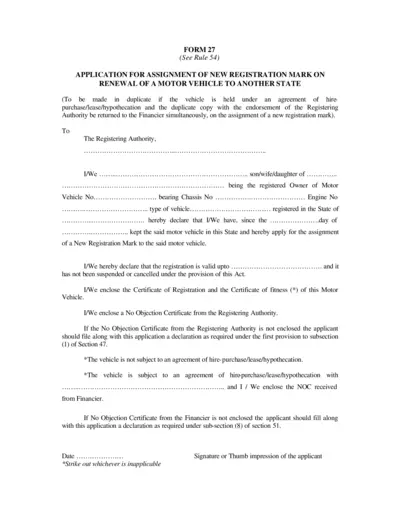
FORM 27 - Application for New Registration Mark Assignment
Form 27 is used for applying for the assignment of a new registration mark for a motor vehicle when relocating to a different state. The form ensures that the vehicle is registered in the new state. It requires details like vehicle number, chassis number, engine number, and more.
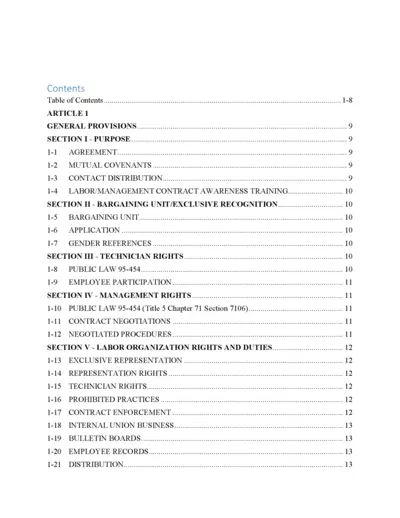
Labor Management Agreement File
This file provides comprehensive details on labor management agreements, including general provisions, bargaining units, technician rights, management rights, and more. It's essential for understanding the rights and responsibilities outlined within labor organization structures. Users can utilize this file to streamline their understanding and compliance with labor agreements.
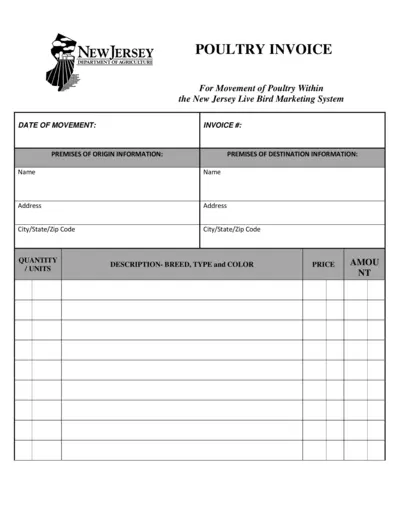
New Jersey Poultry Invoice Form
This file includes detailed instructions for completing a poultry invoice required for the movement of poultry within the New Jersey Live Bird Marketing System. It includes information on premises of origin and destination, quantity, breed, type, and color of poultry, as well as pricing and certification of negative avian influenza status.
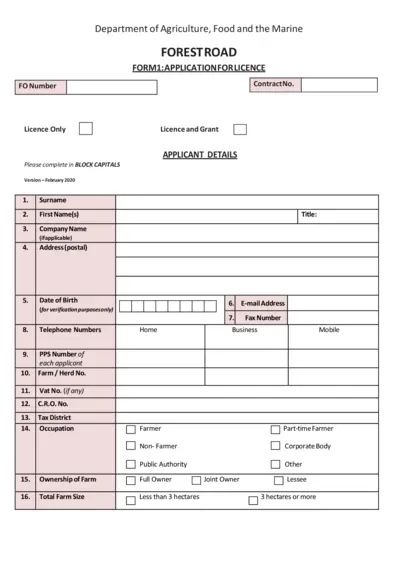
Forest Road Licence Application Form - Department of Agriculture
This is an application form for a forest road licence issued by the Department of Agriculture, Food, and the Marine. The form requires applicant and site details, as well as a declaration and consent section. Detailed instructions, constraints, and ownership information are necessary for completion.
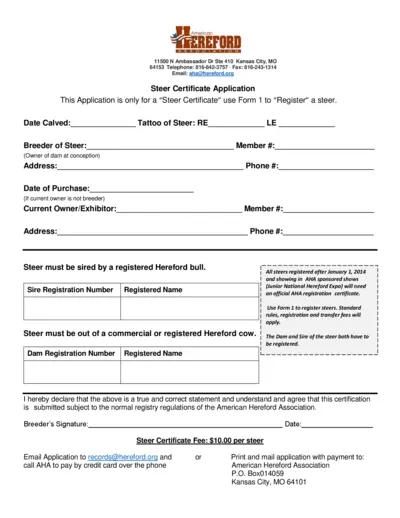
Steer Certificate Application - American Hereford Association
This file is a Steer Certificate Application from the American Hereford Association. It is used to apply for a Steer Certificate for a steer that meets the required criteria. The form includes sections for information about the breeder, current owner, and registration details of the steer.
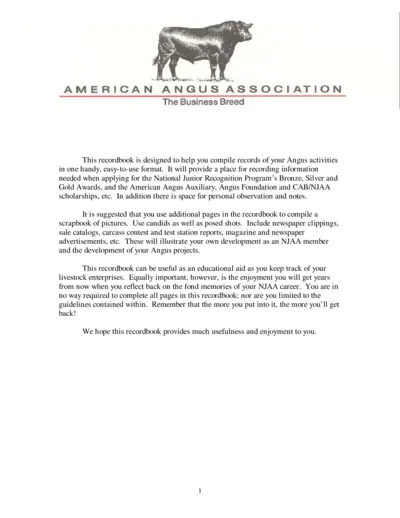
American Angus Association Recordbook for Junior Members
This recordbook is designed to compile records of Angus activities. It is useful when applying for various awards and scholarships. It also serves as an educational aid and a source of fond memories.
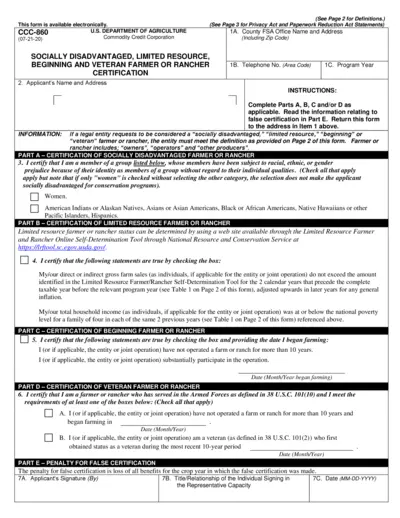
USDA CCC-860 Form: Certification for Farmers and Ranchers
This file is a USDA CCC-860 form used for certifying socially disadvantaged, limited resource, beginning, and veteran farmers or ranchers. It includes instructions on how to complete the form and definitions relevant to the application process. Learn how to determine eligibility and submit the form to the County FSA Office.
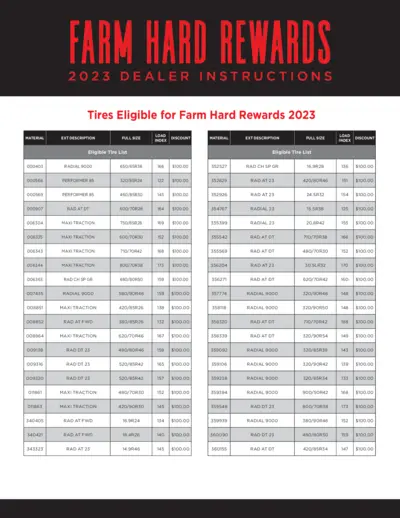
Farm Hard Rewards 2023 Dealer Instructions and Eligible Tires
This document contains detailed instructions for dealers participating in the Farm Hard Rewards program for 2023. Included is a comprehensive list of eligible tires with corresponding load indexes and discounts. Dealers must follow the guidelines for redemption and record-keeping purposes.
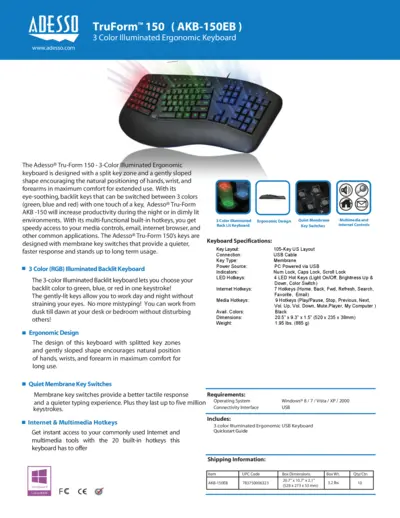
Adesso TruForm 150 Illuminated Ergonomic Keyboard Overview
The Adesso Tru-Form 150 is an illuminated ergonomic keyboard designed with a split key zone to encourage natural hand positioning, perfect for extended use. It features quiet membrane key switches, 20 built-in hotkeys, and is USB powered. The backlit keys can be switched between three colors, making it ideal for night use.
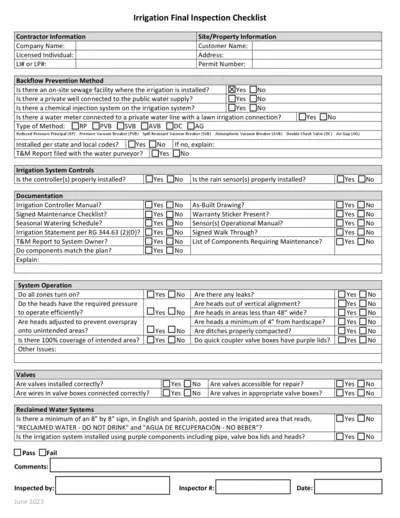
Irrigation Final Inspection Checklist
This Irrigation Final Inspection Checklist is designed to help ensure that all installation and operational requirements are met for irrigation systems. It includes sections for contractor information, site/property information, backflow prevention methods, irrigation system controls, system operation, valves, reclaimed water systems, and more. The checklist assists inspectors in verifying that systems comply with state and local codes and function properly.
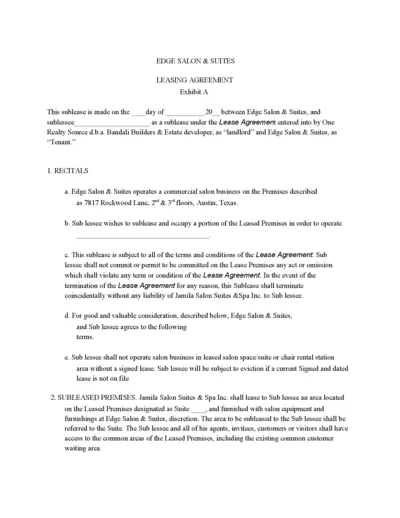
Edge Salon & Suites Sublease Agreement: Lease and Terms.
This file contains the sublease agreement between Edge Salon & Suites and a sublessee. It outlines the terms and conditions for renting a suite or station. It includes details on rent, operating policies, and responsibilities.
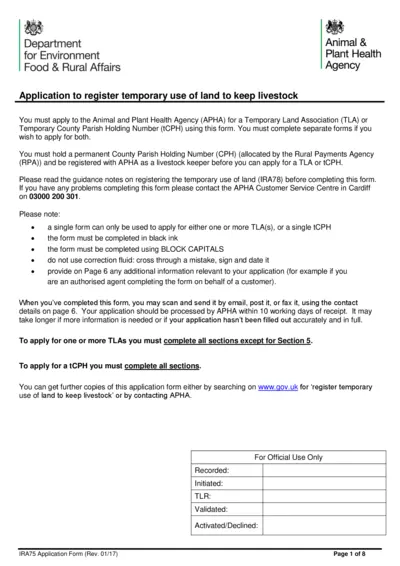
Application to Register Temporary Use of Land for Livestock
This file is used to apply for a Temporary Land Association (TLA) or Temporary County Parish Holding Number (tCPH) to register temporary use of land for keeping livestock. Complete separate forms if applying for both. Ensure you have a permanent CPH allocated by RPA and are registered as a livestock keeper with APHA before applying.